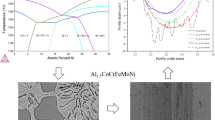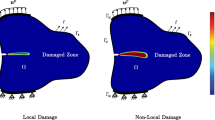Abstract
When an edge cracked shape memory alloy (SMA) plate is loaded, phase transformation around the crack tip results in a non-homogeneous region composed of austenite and martensite phases that affects its fracture behavior. In this work, the size of the phase transformation region surrounding the tip of an edge crack in a thin SMA plate is calculated analytically using a transformation function that governs forward phase transformation, together with crack tip asymptotic stress equations. Stress intensity factors required in the asymptotic equations are obtained from a least squares fit of full displacement field, calculated using finite elements, to asymptotic near-tip opening displacement equation. The present work predicts the size and shape of the transformation region in closed form. For comparison purposes, the region is also calculated using ABAQUS with user defined material subroutines (UMAT) for plane strain and plane stress. Transformation regions calculated analytically and computationally are plotted with experimental, analytical and numerical results available in the literature; the results show a good agreement with the experimental results.









Similar content being viewed by others
References
Anderson TL (2004) Fracture mechanics: fundamentals and applications, 3rd edn. CRC Press, Boca Raton
ASTM (2013) Standard test method for linear-elastic plane-strain fracture toughness \(K_{IC}\) of metallic materials 399–12
Baxevanis T, Chemisky Y, Lagoudas DC (2012) Finite element analysis of the plane strain crack-tip mechanical fields in pseudoelastic shape memory alloys. Smart Mater Struct 21:094012
Birman V (1998) On mode I fracture of shape memory alloy plates. Smart Mater Struct 7:433–437
Brinson LC, Lammering R (1993) Finite element analysis of the behavior of shape memory alloys and their applications. Int J Sol Struct 30:3261–3280
Daly S, Miller A, Ravichandran G, Bhattacharya K (2007) An experimental investigation of crack initiation in thin sheets of nitinol. Acta Mater 55:6322–6330
Du ZZ, Hancock JW (1991) The effect of non-singular stresses on crack-tip constraint. J Mech Phys Solids 39:555–567
Duva JM (1988) The singularity at the apex of a rigid wedge embedded in a nonlinear material. J Appl Mech 55:361–364
Falvo A, Furgiuele F, Leonardi A, Maletta C (2009) Stress-induced martensitic transformation in the crack tip region of a NiTi alloy. J Mater Eng Perform 18:679–685
Freed Y, Banks-Sills L (2007) Crack growth resistance of shape memory alloys by means of a cohesive zone model. J Mech Phys Solids 55:2157–2180
Gollerthan S, Herberg D, Baruj A, Eggeler G (2008) Compact tension testing of martensitic/pseudoplastic NiTi shape memory alloys. Mater Sci Eng A 481–482:156–159
Gollerthan S, Young ML, Baruj A, Frenzel J, Schmahl WW, Eggeler G (2009) Fracture mechanics and microstructure in NiTi shape memory alloys. Acta Mater 57:1015–1025
Halphen B, Nguyen QS (1974) Plastic and visco-plastic materials with generalized potential. Mech Res Commun 1:43–47
Hazar S, Zaki W, Moumni Z, Anlas G (2015) Modeling of steady-state crack growth in shape memory alloys using a stationary method. Int J Plast 67:26–38
Lagoudas DC, Bo Z, Qidwai MA (1996) A unified thermodynamic constitutive model for SMA and finite element analysis of active metal matrix composites. Mech Compos Mater Struct 3:1–43
Lexcellent C, Blanc P (2004) Phase transformation yield surface determination for some shape memory alloys. Acta Mater 52:2317–2324
Lexcellent C, Thiebaud F (2008) Determination of the phase transformation zone at a crack tip in a shape memory alloy exhibiting asymmetry between tension and compression. Scr Mater 59:321–323
Lexcellent C, Laydi MR, Taillebot V (2011) Analytical prediction of the phase transformation onset zone at a crack tip of a shape memory alloy exhibiting asymmetry between tension and compression. Int J Fract 169:1–13
Maletta C, Furgiuele F (2010) Analytical modeling of stress-induced martensitic transformation in the crack tip region of nickel titanium alloys. Acta Mater 58:92–101
Maletta C, Young ML (2011) Stress-induced martensite in front of crack tips in NiTi shape memory alloys: modeling versus experiments. J Mater Eng Perform 20:597–604
Morin C, Moumni Z, Zaki W (2011) Thermomechanical coupling in shape memory alloys under cyclic loadings: experimental analysis and constitutive modeling. Int J Plast 27:1959–1980
Moumni Z (1995) Sur la Modelisation du Changement de Phase Solide : Application aux Materiaux a Memorie de forme et a l’endommagement fragile partiel. Ph.D. Thesis
Moumni Z, Zaki W, Nguyen QS (2008) Theoretical and numerical modeling of solid-solid phase change: application to the description of the thermomechanical behavior of shape memory alloys. Int J Plast 24:614–645
Oral A, Lambros J, Anlas G (2008) Crack initiation in functionally graded materials under mixed mode loading: experiments and simulations. J Appl Mech 75:051110
Panoskaltsis VP, Bahuguna S, Soldatos D (2004) On the thermomechanical modeling of shape memory alloys. Int J Non Linear Mech 39:709–722
Pelton A, Dicello J, Miyazaki S (2000) Optimisation of processing and properties of medical grade nitinol wire. Minim Invasive Ther Allied Technol 9:107–118
Robertson SW, Mehta A, Pelton AR, Ritchie RO (2007) Evolution of crack-tip transformation zones in superelastic Nitinol subjected to in situ fatigue: a fracture mechanics and synchrotron X-ray microdiffraction analysis. Acta Mater 55:6198–6207
Sun QP, Hwang KC (1993a) Micromechanics modelling for the constitutive behavior of polycrystalline shape memory alloys-I. Derivation of general relations. J Mech Phys Solids 41:1–17
Sun QP, Hwang KC (1993b) Micromechanics modelling for the constitutive behavior of polycrystalline shape memory alloys-II. Study of the individual phenomena. J Mech Phys Solids 41:19–33
Taillebot V, Lexcellent C, Vacher P (2012) About the transformation phase zones of shape memory alloys fracture tests on single edge-cracked specimen. Funct Mater Lett 05:1250007
Tanaka K, Sato Y (1986) Analysis of superelastic deformations during isothermal martensitic transformation. Res Mech 17:241–252
Wang GZ (2006) Effects of notch geometry on stress-strain distribution, martensite transformation and fracture behavior in shape memory alloy NiTi. Mater Sci Eng A 434:269–279
Williams ML (1957) On the stress distribution at the base of a stationary crack. J Appl Mech 24:109–114
Xiong F, Liu Y (2007) Effect of stress-induced martensitic transformation on the crack tip stress-intensity factor in Ni-Mn-Ga shape memory alloy. Acta Mater 55:5621–5629
Yi S, Gao S (2000) Fracture toughening mechanism of shape memory alloys due to martensite transformation. Int J Solids Struct 37:5315–5327
Young ML, Gollerthan S, Baruj A, Frenzel J, Schmahl WW, Eggeler G (2013) Strain mapping of crack extension in pseudoelastic NiTi shape memory alloys during static loading. Acta Mater 61:5800–5806
Zaki W, Moumni Z (2007) A three-dimensional model of the thermomechanical behavior of shape memory alloys. J Mech Phys Solids 55:2455–2490
Acknowledgments
Dr. S. Hazar and Prof. G. Anlas would like to acknowledge Bogazici University Scientific Research Projects (BAP) for partial financial support through BAP13A06P4. Prof. Z. Moumni would like to acknowledge the Northwestern Polytechnical University for the financial support.
Author information
Authors and Affiliations
Corresponding author
Appendix
Appendix
The Helmholtz free energy used in ZM model is formulated as follows:
In the equation above \({\varepsilon }_{ij}^{M}\) and \({\varepsilon }_{ij}^{A}\) are local strain tensors of martensite and austenite phases. \(\varGamma \) is defined as
In the model, Reuss scheme is used to relate the total strain \({\varepsilon }_{ij}\) to the strains of austenite and martensite phases as given below:
the internal state variable \(\zeta \) should be bounded in the interval [0, 1], therefore:
and the equivalent orientation strain, \(\varepsilon _{0}\) as shown in Fig. 1b, has the following maximum value:
Equations (23), (24) and (25) are used to build the following constraints potential \({\varPsi }_{c}\) (Moumni 1995):
where the Lagrange multipliers \(\lambda \), \(\mu \), \(\nu _{1}\), \(\nu _{2}\) and \(\mu \) obey the following conditions:
The sum of the Helmholtz energy density, Eq. (21), and the potential \({\varPsi }_{c}\), Eq. (26), gives the Lagrangian, which is then used to derive the state equations, and the following stress–strain relation is obtained:
in which \({S_{ijkl}}\) is the compliance tensor defined as:
where \(S_{ijkl}^{A}\) and \(S_{ijkl}^{M}\) are the compliance tensors of austenite and martensite phases respectively.
According to the theory of generalized standard materials with internal constraints represented by Halphen and Nguyen (1974), the thermodynamic forces that are related to the internal state variables \(\zeta \) and \({\varepsilon }_{ij}^{{ori}}\) are sub-gradients of a pseudo-potential. The pseudo-potential of dissipation defined by Zaki and Moumni (2007) is given as follows:
In the equation above Y is a positive material constant associated with \(\sigma _{rs}\). The pseudo-potential of dissipation, \(\mathcal {D}(\dot{\zeta },\dot{\varepsilon }_{ij}^{{ori}})\), allows the definition of transformation function, \(F_{\zeta }\) given in Eq. (1).
Rights and permissions
About this article
Cite this article
Hazar, S., Anlas, G. & Moumni, Z. Evaluation of transformation region around crack tip in shape memory alloys. Int J Fract 197, 99–110 (2016). https://doi.org/10.1007/s10704-015-0069-3
Received:
Accepted:
Published:
Issue Date:
DOI: https://doi.org/10.1007/s10704-015-0069-3




